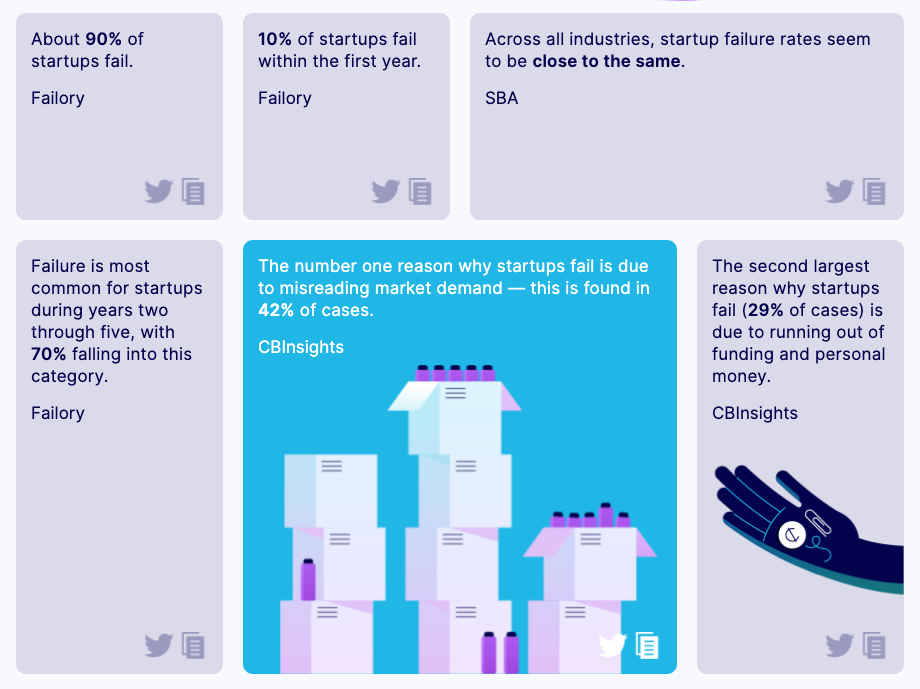You hear that? That’s the sound of another startup that just failed. And another. And another.
Another. Another. Another. Another.
This perpetual sound of failure equates to the implosion of 90% of all startups!!
Read that again because it’s quite a sobering statistic, not to mention the fact that 10% of startups fail within the first year. That’s an extraordinary perspective into the outcomes of all of the hopes and dreams and hard work of thousands of entrepreneurs, and billions of dollars spent in capital – all wasted each year.

As an entrepreneur, I know about failure. I’ve made quite a few mistakes, and in turn I’ve gained some extremely valuable insight from failing.
And my number one lesson learned in entrepreneurship and product development is the critical need to use an MVP as the starting point for building great products and companies that customers love.
What is a Minimum Viable Product (MVP)?
MVP stands for “minimum viable product” and is a concept that Eric Ries introduced as part of his Lean Startup methodology, where the MVP is a development technique in which you build a new product with enough features to attract early-adopters and validate a product idea at the beginning of the product development cycle.

What is the Purpose of a Minimum Viable Product?
Looking further at the startup failure statistics reveals that the number one reason for failure is that there’s no market for the product built, where the target audience doesn’t find any value in the product and therefore don’t use it.

And that’s the real purpose of an MVP, where you’re focused on “should it be built?” instead of “can it be built?” by validating that there is a market for your product before spending a ton of time and money on building out the full product. The MVP plays a central role in Agile development because Agile methodology is built on validating and iterating products based on user input.

Other purposes of an MVP include the following:
- Release a product to the market as quickly as possible
- Test an idea with real users before committing a large budget to the product’s full development
- Learn what resonates with the company’s target market and what doesn’t
The MVP Process
The common MVP approach of “Build > Measure > Learn” is oversimplified, where I’ve seen most startups and teams just dive in and begin development because “build” is the first step in the process. And this almost always leads to bad outcomes. You really need to spend some time upfront defining your problem and a high-level solution, and then doing market research before you start defining any requirements.
With that said, here’s a typical 5 step MVP process that I often utilize:

Don’t be fooled into believing the MVP process is over after you finish all 5 steps, where it looks more like a series of Build/Measure/Learn loops (see image below). Most startups might only need a few iterations, but some may need 10 or 20 iterations before landing on a MVP solution that customers find valuable.
And that’s totally fine, remember that the goal of the MVP is to start the learning process – not end it – in order to test your fundamental business hypotheses. There’s no shortcut for the necessary hard work in creating and validating an MVP.

From the customer’s interaction with the MVP, the product can then go through cycles of improvement that result in a full-featured product that customers will love.

What are the Various Types of MVP’s?
The term MVP is not just about developing great software, where it can be applied to any type of startup activity, even if you’re at a large company developing an innovative product or service.
There’s a lot of types of MVP’s, from the use of a concierge service via phone/email to test the market without any technology to a website frontend that uses manual processes to building out single feature products.

Examples of MVP’s
Take a look at some famous examples of tech entrepreneurs using a minimum viable product to validate and improve upon their early products:
- Zappos founder Nick Swinmurn took pictures of shoes at a shoe store and posted these pictures on his website. Whenever a customer ordered shoes on his site, he went back to the store to purchase those shoes, then packed and shipped the shoes to the customer.
- Dropbox founder Drew Houston created a simple video demoing how Dropbox worked. The team initially faced challenges pitching to potential investors because these investors couldn’t see how the product worked. The video, narrated by Drew, visually demonstrated Dropbox’s usefulness.
- The three founders of Airbnb piled air beds into their apartment and put up an ad prior to a large political convention. People actually responded to the ad and ended up renting the air beds.
Again, the minimum viable product is more important as a learning tool rather than being about the product itself – it’s to first validate whether customers will use the product, then to highlight areas of refinement and additional useful features.





One thought on “90% of Startups Fail Because They Don’t Understand How to Utilize a Minimum Viable Product (MVP) to Develop Products that Customers Love”